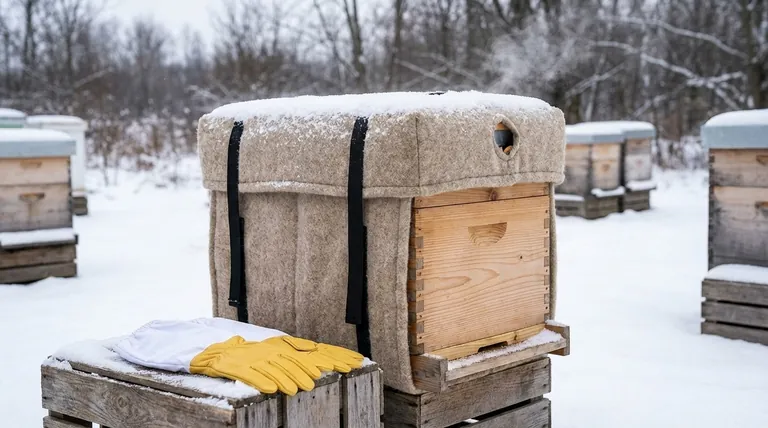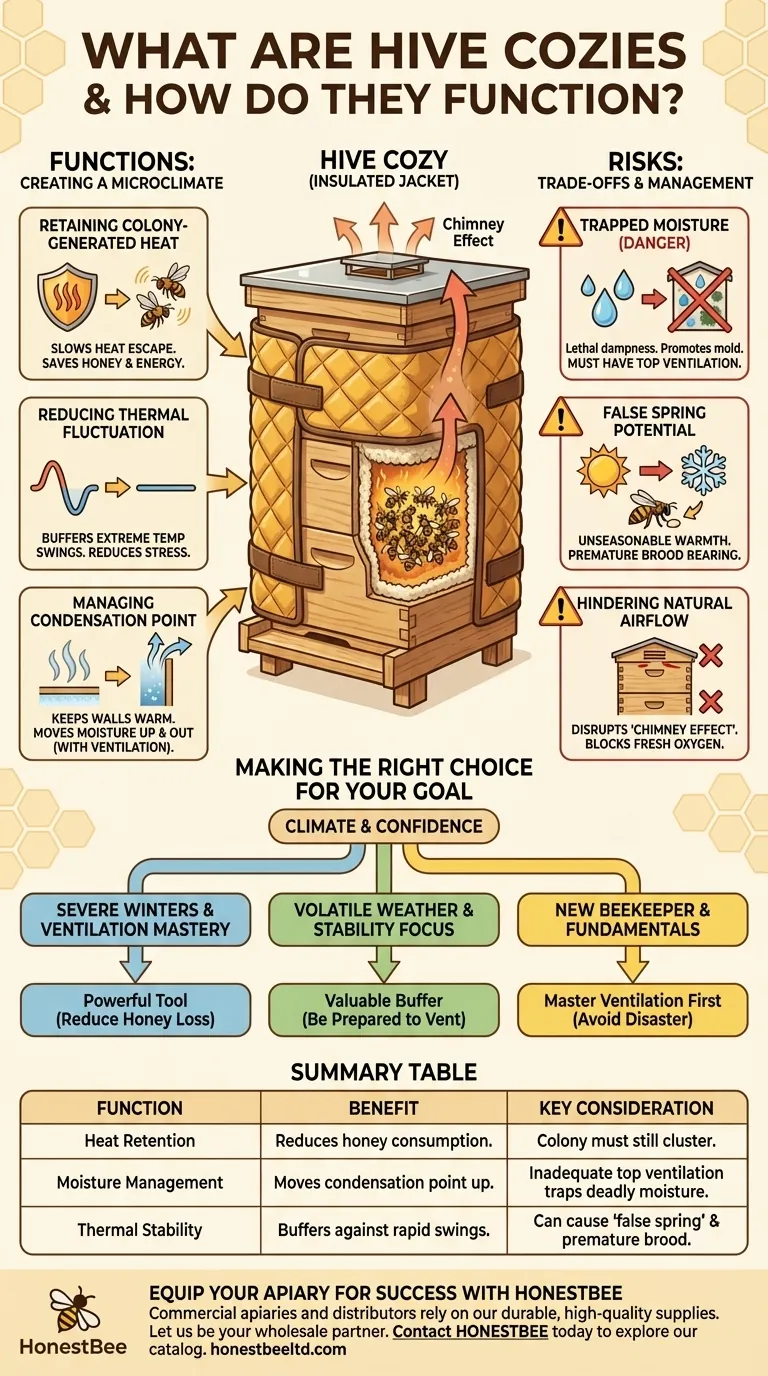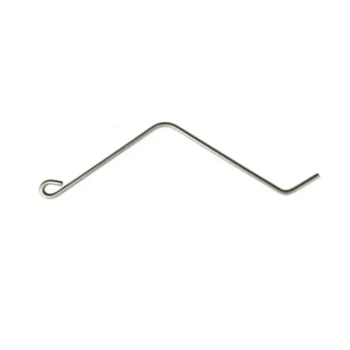At its core, a hive cozy is an insulated jacket designed to wrap around a beehive during cold weather. Typically made of durable, weather-resistant fabric or plastic, these covers contain an insulating material like wool, foam, or polyester. They are built to fit standard hive sizes and are secured in place with fasteners like Velcro straps, providing an external layer of insulation for the colony within.
While a hive cozy's primary role is to provide insulation against cold, its true value—and its greatest risk—lies in how it affects the hive's moisture and ventilation. Proper management of these factors is more critical for winter survival than temperature alone.

How a Hive Cozy Alters the Hive Environment
A hive cozy fundamentally changes the physics of the hive, creating a microclimate that can either help or harm the colony depending on how it's managed. Understanding these functions is key to using one successfully.
Retaining Colony-Generated Heat
Bees do not heat the entire hive; they form a tight cluster and generate heat by vibrating their wing muscles. This process consumes significant energy, which comes from their stored honey.
A hive cozy acts like insulation on a house, slowing the rate at which this precious heat escapes through the hive walls. This means the colony expends less energy and consumes fewer honey stores to maintain its critical cluster temperature.
Reducing Thermal Fluctuation
Winter weather often includes rapid temperature swings. A sunny afternoon can warm a hive, only to be followed by a plummeting temperature at night.
The cozy acts as a thermal buffer, dampening these extreme fluctuations. This stability reduces stress on the colony and prevents the cluster from having to constantly expand and contract, saving vital energy.
Managing the Condensation Point
As bees metabolize honey, they release a significant amount of water vapor. In an uninsulated hive, this warm, moist air rises and hits the cold inner cover, where it condenses into water and drips back down on the bees—a fatal scenario.
A cozy keeps the hive walls warmer, which in turn keeps the inner surfaces of the hive warmer. This encourages the condensation point to move higher up, ideally towards a dedicated ventilation opening where the moist air can escape harmlessly.
Understanding the Trade-offs and Risks
A hive cozy is not a "set and forget" solution. Misuse can create a more dangerous environment than having no insulation at all.
The Danger of Trapped Moisture
The single greatest risk of using a hive cozy is trapping moisture. If you wrap a hive but fail to provide adequate top ventilation, you are creating a sealed, damp environment.
A damp, insulated hive is a death trap. It promotes mold and mildew growth on combs and, more importantly, a wet bee cannot survive the cold. A dry, cold bee is far better off than a damp, cool bee.
The Potential for a "False Spring"
On an unseasonably warm winter day, a highly effective cozy can cause the internal hive temperature to rise significantly. This may trick the queen into thinking spring has arrived, causing her to begin laying eggs.
If a cold snap follows, the colony may not have enough bees to keep this new, vulnerable brood warm, leading to its death and wasted colony resources.
Hindering Natural Airflow
Improper installation can be just as dangerous as poor design. A cozy that blocks the hive's upper or lower entrances can disrupt the natural "chimney effect" of airflow that bees rely on to vent moisture and bring in fresh oxygen.
Making the Right Choice for Your Goal
The decision to use a hive cozy depends entirely on your climate, your confidence in managing ventilation, and your overall beekeeping philosophy.
- If your primary focus is surviving long, severe winters: A cozy can be a powerful tool to reduce honey consumption and winter losses, but only if you provide excellent, unobstructed top ventilation.
- If your primary focus is mitigating temperature swings: A cozy can provide valuable stability in climates with volatile weather, but be prepared to potentially vent or remove it during extended warm spells.
- If you are a new beekeeper: First master the principles of hive ventilation and moisture control without a cozy. Adding a wrap before you understand these fundamentals can mask problems and lead to disaster.
Ultimately, a hive cozy is a tool that amplifies your management—use it to support a dry, well-ventilated hive, not as a substitute for it.
Summary Table:
| Function | Benefit | Key Consideration |
|---|---|---|
| Heat Retention | Reduces honey consumption by slowing heat loss. | Colony must still form a cluster to generate heat. |
| Moisture Management | Moves condensation point upward with proper ventilation. | Inadequate top ventilation traps deadly moisture. |
| Thermal Stability | Buffers hive against rapid external temperature swings. | Can cause a "false spring" and premature brood rearing. |
Equip Your Apiary for Success with HONESTBEE
Mastering winter beekeeping requires the right tools and knowledge. A hive cozy is just one part of a successful strategy. At HONESTBEE, we supply commercial apiaries and beekeeping equipment distributors with the durable, high-quality supplies needed to build resilient operations.
Let us be your wholesale partner in beekeeping success.
Contact HONESTBEE today to discuss your equipment needs and explore our full product catalog.
Visual Guide

Related Products
- Beekeeping Gloves Goatskin Leather with Long Cotton Sleeve for Beekeepers
- In-Hive Dual Compartment Frame Bee Feeder for Targeted Colony Nutrition
- Professional Galvanized Hive Strap with Secure Locking Buckle for Beekeeping
- Boardman Entrance Bee Feeder Durable Galvanized Steel and Wood Construction for Beekeeping
- Mesh Ventilated 3 Layer Goatskin Beekeepers Gloves for Beekeeping
People Also Ask
- What are the advantages of goatskin leather gloves for beekeeping? Superior Sting Protection for Your Apiary
- Why do some experienced beekeepers choose not to wear gloves? For Superior Dexterity & Hive Welfare
- What is the safest way to handle frames in beekeeping? Master Gentle Handling for a Calm Hive
- What are the features of ventilated bee gloves? Stay Cool & Dexterous in Warm Weather
- What is the difference between cleaning cow leather and goat leather beekeeping gloves? Tailor Your Care for Longevity



















